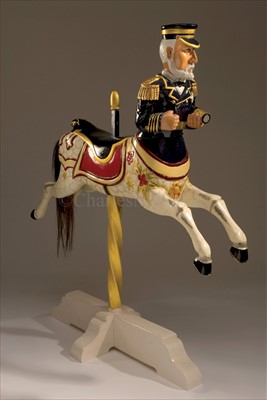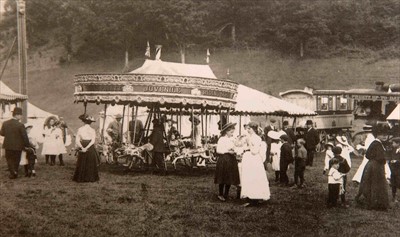22nd Oct, 2008 12:00
Maritime and Scientific Models, Instruments & Art (Association)
104
[M] A UNIQUE FAIRGROUND CENTAUR CARVING OF CAPTAIN...
A UNIQUE FAIRGROUND CENTAUR CARVING OF CAPTAIN E.J. SMITH, CIRCA 1903
by J.R. & A. Anderson and depicting Smith in uniform with a white star on his tunic and holding a telescope, hinged to the body shown at full stretch with horse hair tail, finished in dappled white, red, blue, gold and other colours, now mounted on a twisted gold pole mount on cross section base with plaques - 48 x 43in. (122 x 109cm.) Together with Roundabout Relics by John Barker in which this carving is discussed; and a quantity of historical details and photographs.
Captain Edward Smith, R.N.R. was already a semi-famous character long before his name was immortalised by the disaster that overwhelmed Titanic in 1912. Joining the White Star Line in 1880, he became established as the "millionaires" captain, comfortable with his illustrious and wealthy passengers, he was a popular and charismatic ambassador for his Company. As a member of the Royal Navy Reserve it was his duty to respond when called to service during the Boer War of 1899-1901 and in that capacity and as master of R.M.S. Majestic, he took two loads of troops to the war zone without incident. For his efforts, King Edward VII awarded him the Transport Medal with Africa Clasp. It is perhaps not surprising therefore that Anderson's selected him as one of their Hero's of the Boer War to accompany three other centaur carvings (along with four horses, two cockerels and two wild boars) on the hand turned ride commissioned by fairground owner Thomas Pruett.
The carving has been in several collections in recent years, but after many re-paints his identity had been lost. It was re-discovered in 2005 and has since undergone a complete restoration and had his original colour scheme reinstated.
The Anderson family were originally ship carvers and left Bristol to work at Rotherhithe where they produced fine figureheads and decoration. When this source of revenue died out, in common with a lot of other marine carvers, they turned their skills to producing quality work for the burgeoning fairground industry. Unsurprisingly, fairground rides often enjoyed a strong maritime theme and the carver's work was of such quality that it is often mistaken for genuine marine work.
Literature: Barker, J: Roundabout Relics, Jumper Books, 2006, p.77, 126-131 inc.
Thomas, P.N:British Figurehead and Ship Carvers, Waine Research, 1995, p.22.
(a lot)
by J.R. & A. Anderson and depicting Smith in uniform with a white star on his tunic and holding a telescope, hinged to the body shown at full stretch with horse hair tail, finished in dappled white, red, blue, gold and other colours, now mounted on a twisted gold pole mount on cross section base with plaques - 48 x 43in. (122 x 109cm.) Together with Roundabout Relics by John Barker in which this carving is discussed; and a quantity of historical details and photographs.
Captain Edward Smith, R.N.R. was already a semi-famous character long before his name was immortalised by the disaster that overwhelmed Titanic in 1912. Joining the White Star Line in 1880, he became established as the "millionaires" captain, comfortable with his illustrious and wealthy passengers, he was a popular and charismatic ambassador for his Company. As a member of the Royal Navy Reserve it was his duty to respond when called to service during the Boer War of 1899-1901 and in that capacity and as master of R.M.S. Majestic, he took two loads of troops to the war zone without incident. For his efforts, King Edward VII awarded him the Transport Medal with Africa Clasp. It is perhaps not surprising therefore that Anderson's selected him as one of their Hero's of the Boer War to accompany three other centaur carvings (along with four horses, two cockerels and two wild boars) on the hand turned ride commissioned by fairground owner Thomas Pruett.
The carving has been in several collections in recent years, but after many re-paints his identity had been lost. It was re-discovered in 2005 and has since undergone a complete restoration and had his original colour scheme reinstated.
The Anderson family were originally ship carvers and left Bristol to work at Rotherhithe where they produced fine figureheads and decoration. When this source of revenue died out, in common with a lot of other marine carvers, they turned their skills to producing quality work for the burgeoning fairground industry. Unsurprisingly, fairground rides often enjoyed a strong maritime theme and the carver's work was of such quality that it is often mistaken for genuine marine work.
Literature: Barker, J: Roundabout Relics, Jumper Books, 2006, p.77, 126-131 inc.
Thomas, P.N:British Figurehead and Ship Carvers, Waine Research, 1995, p.22.
(a lot)
Sold for £14,880
(inc. buyer's premium of 24%)
A UNIQUE FAIRGROUND CENTAUR CARVING OF CAPTAIN E.J. SMITH, CIRCA 1903
by J.R. & A. Anderson and depicting Smith in uniform with a white star on his tunic and holding a telescope, hinged to the body shown at full stretch with horse hair tail, finished in dappled white, red, blue, gold and other colours, now mounted on a twisted gold pole mount on cross section base with plaques - 48 x 43in. (122 x 109cm.) Together with Roundabout Relics by John Barker in which this carving is discussed; and a quantity of historical details and photographs.
Captain Edward Smith, R.N.R. was already a semi-famous character long before his name was immortalised by the disaster that overwhelmed Titanic in 1912. Joining the White Star Line in 1880, he became established as the "millionaires" captain, comfortable with his illustrious and wealthy passengers, he was a popular and charismatic ambassador for his Company. As a member of the Royal Navy Reserve it was his duty to respond when called to service during the Boer War of 1899-1901 and in that capacity and as master of R.M.S. Majestic, he took two loads of troops to the war zone without incident. For his efforts, King Edward VII awarded him the Transport Medal with Africa Clasp. It is perhaps not surprising therefore that Anderson's selected him as one of their Hero's of the Boer War to accompany three other centaur carvings (along with four horses, two cockerels and two wild boars) on the hand turned ride commissioned by fairground owner Thomas Pruett.
The carving has been in several collections in recent years, but after many re-paints his identity had been lost. It was re-discovered in 2005 and has since undergone a complete restoration and had his original colour scheme reinstated.
The Anderson family were originally ship carvers and left Bristol to work at Rotherhithe where they produced fine figureheads and decoration. When this source of revenue died out, in common with a lot of other marine carvers, they turned their skills to producing quality work for the burgeoning fairground industry. Unsurprisingly, fairground rides often enjoyed a strong maritime theme and the carver's work was of such quality that it is often mistaken for genuine marine work.
Literature: Barker, J: Roundabout Relics, Jumper Books, 2006, p.77, 126-131 inc.
Thomas, P.N:British Figurehead and Ship Carvers, Waine Research, 1995, p.22.
(a lot)
by J.R. & A. Anderson and depicting Smith in uniform with a white star on his tunic and holding a telescope, hinged to the body shown at full stretch with horse hair tail, finished in dappled white, red, blue, gold and other colours, now mounted on a twisted gold pole mount on cross section base with plaques - 48 x 43in. (122 x 109cm.) Together with Roundabout Relics by John Barker in which this carving is discussed; and a quantity of historical details and photographs.
Captain Edward Smith, R.N.R. was already a semi-famous character long before his name was immortalised by the disaster that overwhelmed Titanic in 1912. Joining the White Star Line in 1880, he became established as the "millionaires" captain, comfortable with his illustrious and wealthy passengers, he was a popular and charismatic ambassador for his Company. As a member of the Royal Navy Reserve it was his duty to respond when called to service during the Boer War of 1899-1901 and in that capacity and as master of R.M.S. Majestic, he took two loads of troops to the war zone without incident. For his efforts, King Edward VII awarded him the Transport Medal with Africa Clasp. It is perhaps not surprising therefore that Anderson's selected him as one of their Hero's of the Boer War to accompany three other centaur carvings (along with four horses, two cockerels and two wild boars) on the hand turned ride commissioned by fairground owner Thomas Pruett.
The carving has been in several collections in recent years, but after many re-paints his identity had been lost. It was re-discovered in 2005 and has since undergone a complete restoration and had his original colour scheme reinstated.
The Anderson family were originally ship carvers and left Bristol to work at Rotherhithe where they produced fine figureheads and decoration. When this source of revenue died out, in common with a lot of other marine carvers, they turned their skills to producing quality work for the burgeoning fairground industry. Unsurprisingly, fairground rides often enjoyed a strong maritime theme and the carver's work was of such quality that it is often mistaken for genuine marine work.
Literature: Barker, J: Roundabout Relics, Jumper Books, 2006, p.77, 126-131 inc.
Thomas, P.N:British Figurehead and Ship Carvers, Waine Research, 1995, p.22.
(a lot)
Auction: Maritime and Scientific Models, Instruments & Art (Association), 22nd Oct, 2008




